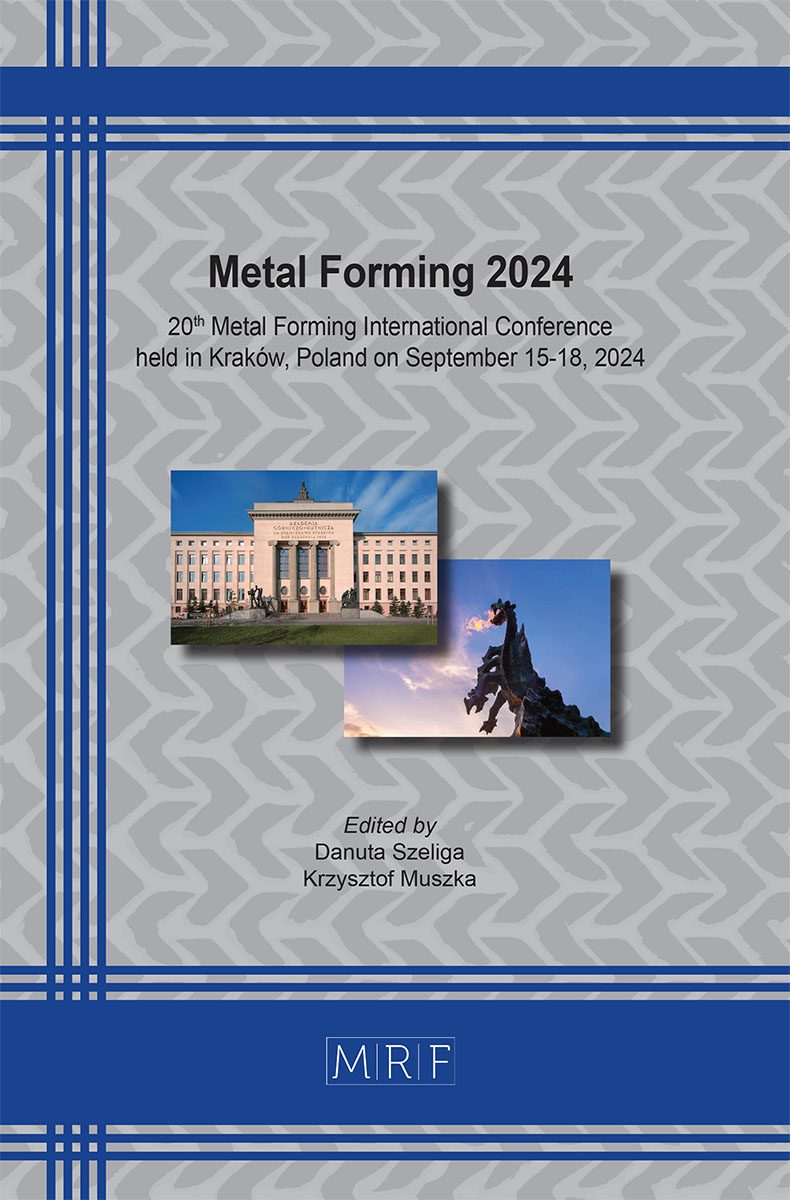–
Achievement of martensite strengthening in titanium alloy thin-walled components via non-equilibrium hot stamping
CHANG Shupeng, HUANG Shuaijun, WANG Kehuan, LI Zhe, WEN Zehua, LIU Gang
download PDFAbstract. The hot stamping using cold die technology demonstrates great advantages in improving the forming efficiency of titanium alloy thin-walled components. Martensite has been widely employed to strengthen steels, yet few applications were reported in titanium alloys. The main reason is that the martensite microstructure embrittles titanium alloys easily. In this paper, the non-equilibrium hot stamping technology is proposed for titanium alloys to solve the strength-ductility trade-off caused by martensite microstructure. Rapid heating is used to control phase transformation and grain growth during the short-time heating and obtain non-equilibrium microstructure. Non-equilibrium hot stamping experiments of the Ti-6Al-4V alloy were carried out to validate the feasibility. Results show that the rapid heating in the single β-phase region could avoid overgrowth of β grains and lead to the formation of fully fine martensite after water quenching. An Ω-shaped component with fully martensite microstructure were successfully formed by non-equilibrium hot stamping technology. The formed component has a maximum tensile strength of 1153.9 MPa, with a total elongation of 8.0% at room temperature, and the tensile strength is 13.0% higher than that of the as-received sheet.
Keywords
Rapid Heating, Hot Stamping, Non-Equilibrium Microstructure, Martensite, Mechanical Properties
Published online 9/15/2024, 8 pages
Copyright © 2024 by the author(s)
Published under license by Materials Research Forum LLC., Millersville PA, USA
Citation: CHANG Shupeng, HUANG Shuaijun, WANG Kehuan, LI Zhe, WEN Zehua, LIU Gang, Achievement of martensite strengthening in titanium alloy thin-walled components via non-equilibrium hot stamping, Materials Research Proceedings, Vol. 44, pp 744-751, 2024
DOI: https://doi.org/10.21741/9781644903254-79
The article was published as article 79 of the book Metal Forming 2024
![]() Content from this work may be used under the terms of the Creative Commons Attribution 3.0 license. Any further distribution of this work must maintain attribution to the author(s) and the title of the work, journal citation and DOI.
Content from this work may be used under the terms of the Creative Commons Attribution 3.0 license. Any further distribution of this work must maintain attribution to the author(s) and the title of the work, journal citation and DOI.
References
[1] S. Yuan, Fundamentals and Processes of Fluid Pressure Forming Technology for Complex Thin-Walled Components, Engineering 7 (2021) 358-366. https://doi.org/10.1016/j.eng.2020.08.014
[2] K.H. Wang, L.L. Wang, K.L. Zheng, Z.B. He, D.J. Politis, G. Liu, S.J. Yuan, High-efficiency forming processes for complex thin-walled titanium alloys components: state-of-the-art and perspectives, Int. J. Extreme Manuf. 2 (2020) 20-43. https://doi.org/10.1088/2631-7990/ab949b
[3] E.-L. Odenburger, R. Pederson, M. Oldenburg, Finite Element Modeling and Validation of Springback and Stress Relaxation in the Thermo-Mechanical Forming of Thin Ti-6Al-4V Sheets, Int. J. Adv. Manuf. Technol. 104 (2019). https://doi.org/10.1007/s00170-019-04071-9
[4] K. Mori, P.F. Bariani, B.-A. Behrens, A. Brosius, S. Bruschi, T. Maeno, M. Merklein, J. Yanagimoto, Hot stamping of ultra-high strength steel parts, CIRP Ann.-Manuf. Techn. 66 (2017) 755-777. https://doi.org/10.1016/j.cirp.2017.05.007
[5] Y. Nakagawa, K. Mori, T. Maeno, Y. Nakao, Reduction in holding time at bottom dead centre in hot stamping by water and die quenching, Procedia Manuf. 15 (2018) 1111-1118. https://doi.org/10.1016/j.promfg.2018.07.380
[6] Y.F. Li, Y. Chen, S.H. Li, Phase transformation testing and modeling for hot stamping of boron steel considering the effect of the prior austenite deformation, Mater. Sci. Eng. A-Struct. Mater. Prop. Microstruct. Process. 821 (2021). https://doi.org/10.1016/j.msea.2021.141447
[7] M. Kopec, K.H. Wang, D.J. Politis, Y.Q. Wang, L.L. Wang, J.G. Lin, Formability and microstructure evolution mechanisms of Ti-6A-l4V alloy during a novel hot stamping process, Mater. Sci. Eng. A-Struct. Mater. Prop. Microstruct. Process. 719 (2018) 72-81. https://doi.org/10.1016/j.msea.2018.02.038
[8] Y.H. Mu, X.M. Yang, B.Y. Wang, H.T. Qu, F.L. Chen, A novel triple-layer hot stamping process of titanium alloy TC4 sheet for enhancing formability and its application in a plug socket part, Int. J. Lightweight Mater. Manuf. 6 (2023) 189-197. https://doi.org/10.1016/j.ijlmm.2022.10.003
[9] Z. Hamedon, K. Mori, T. Maeno, Y. Yamashita, Hot stamping of titanium alloy sheet using resistance heating, NMSTU 5 (2013).
[10] T. Maeno, Y.Yamashita, K. Mori, Hot stamping of titanium alloy sheets into U shape with concave bottom and joggle using resistance heating, Key Eng. Mater. 716 (2016) 915–922. https://doi.org/10.4028/www.scientific.net/KEM.716.915
[11] K.H. Wang, M. Kopec, S.P. Chang, B. Qu, J. Liu, D.J. Politis, L.L. Wang, G. Liu, Enhanced formability and forming efficiency for two-phase titanium alloys by Fast light Alloys Stamping Technology (FAST), Mater. Des. 194 (2020). https://doi.org/10.1016/j.matdes.2020.108948
[12] S.P. Chang, K.H. Wang, B. Wang, M. Kopec, Z. Li, L.L. Wang, G. Liu, Effects of rapid heating on non-equilibrium microstructure evolution and strengthening mechanisms of titanium alloy, Mater. Sci. Eng. A-Struct. Mater. Prop. Microstruct. Process. 880 (2023). https://doi.org/10.1016/j.msea.2023.145337
[13] Y. Chong, T. Bhattacharjee, J. Yi, A. Shibata, N. Tsuji, Mechanical properties of fully martensite microstructure in Ti-6Al-4V alloy transformed from refined beta grains obtained by rapid heat treatment (RHT), Scripta Mater. 138 (2017) 66-70. https://dx.doi.org/10.1016/j.scriptamat.2017.05.038












